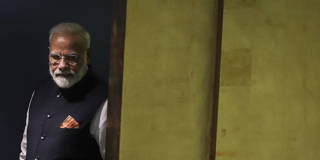India is no longer the model free-market democracy that Westerners spent years imagining, encouraging, and touting. With Prime Minister Narendra Modi having bent the media, big business, and democratic institutions to his will, India's markets and politics are becoming less free – as the ongoing election is set to confirm.
HONG KONG – A couple of months before India’s general election began on April 19 (voting will continue until June 1), the opposition Indian National Congress made a stunning disclosure at a press conference in New Delhi. Apparently, Prime Minister Narendra Modi’s government had frozen some of the party’s main bank accounts and slapped it with an outsize bill for a minor tax-filing lapse five years earlier, leaving it with no money even to pay for electricity or salaries, let alone conduct an election campaign. The freeze was soon lifted, but the message was clear: this wasn’t going to be a regular election.
Though Congress had ruled India for most of the period since independence in 1947, Modi’s rise to national power in 2014 has left the party flailing. Congress officials decried the account freeze as a “deep assault on India’s democracy,” but this was merely the latest example in a longer-running saga. Modi’s government has spent a decade eroding civil liberties and minority rights, curtailing dissent, undermining democratic institutions, and building a cult of personality. While Western governments continue to pretend that India is the world’s largest democracy, the country is beginning to resemble a Central Asian dictatorship.
“One of the Worst”
Those monitoring the health of democracy around the world are unanimous in their bleak prognosis of India under Modi. Freedom House describes India as only “partly free,” and the V-Dem Institute in Sweden has, since 2018, categorized it as an “electoral autocracy.” In its 2024 Democracy Report, V-Dem singles India out as “one of the worst autocratizers lately.”

HONG KONG – A couple of months before India’s general election began on April 19 (voting will continue until June 1), the opposition Indian National Congress made a stunning disclosure at a press conference in New Delhi. Apparently, Prime Minister Narendra Modi’s government had frozen some of the party’s main bank accounts and slapped it with an outsize bill for a minor tax-filing lapse five years earlier, leaving it with no money even to pay for electricity or salaries, let alone conduct an election campaign. The freeze was soon lifted, but the message was clear: this wasn’t going to be a regular election.
Though Congress had ruled India for most of the period since independence in 1947, Modi’s rise to national power in 2014 has left the party flailing. Congress officials decried the account freeze as a “deep assault on India’s democracy,” but this was merely the latest example in a longer-running saga. Modi’s government has spent a decade eroding civil liberties and minority rights, curtailing dissent, undermining democratic institutions, and building a cult of personality. While Western governments continue to pretend that India is the world’s largest democracy, the country is beginning to resemble a Central Asian dictatorship.
“One of the Worst”
Those monitoring the health of democracy around the world are unanimous in their bleak prognosis of India under Modi. Freedom House describes India as only “partly free,” and the V-Dem Institute in Sweden has, since 2018, categorized it as an “electoral autocracy.” In its 2024 Democracy Report, V-Dem singles India out as “one of the worst autocratizers lately.”